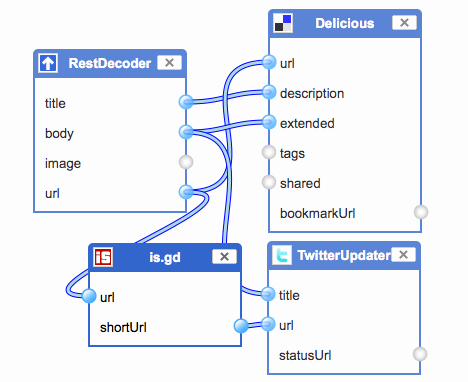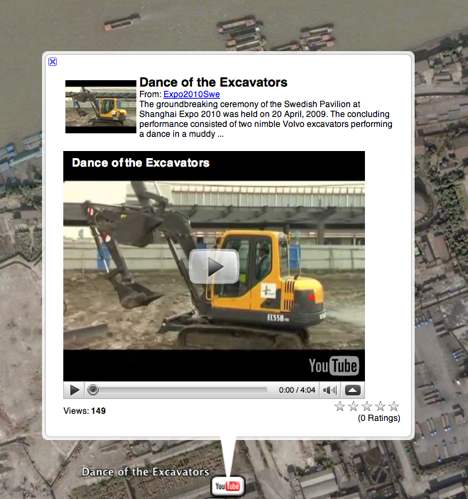-
Is India's Bhuvan satellite maps site being rolled out this week?
All posts by Stefan Geens
links for 2009-05-25
-
Project site and blog of Sean Askay's amazing KML file mapping US and coalition troop deaths in Iraq, Afghanistan
Augmented reality apps: Sky Map for Android is just the beginning
I experienced Android envy for the first time last week when Google released their Sky Map for Android — envy, because in addition to using GPS and pitch & roll detection, the app also puts Android’s built in magnetometer to work, and that is not something my iPhone has.
Rumor has it, however, that the next iPhone will come with a magnetometer, and so we can assume that by this time next year, all smartphones will avail themselves of the GPS/pitch & roll detection/compass technology trio. What other uses could this technology be put to, besides pointing you to objects in the sky?
Probably the biggest potential is for photographs. If the phone can tell at what angle your are holding it and in what direction you are pointing it when taking a photo, in addition to where exactly and when (and what the viewing angle of the lens is), and you upload all this metadata along with the photo to the cloud, then services like Panoramio and PhotoSynth will have all the information they need to start constructing a crowdsourced 3D simulacrum of the world, photo by photo. PhotoSynth already does some of this by trying to calculate roll, pitch, direction and viewfinder angle of a photo by comparing it to photos taken in the vicinity, but it should get a lot better if it has starting values for these variables, even if they are not completely accurate.
I wonder how long it will take for DSLRs to incorporate this technology. There have been GPS modules for cameras for a while now, but (to me at least) the advantage of having coordinate metadata attached immediately to the image file by the camera is outweighed by the requirement of having the GPS unit be physically attached to the camera — Especially as a proper GPS unit can be kept in your rucksack, whose info you can use when downloading the photos to your computer.
Cheap pitch, roll and direction detection changes the game, however. Perhaps at first we’ll be taping our Androids and iPhones to the back of our DSLRs, but it can’t be long before camera manufacturers realize the benefits of having this information recorded by default. Then, when we upload our photos to the web, we’ll be able to automatically generate KML that lets us view the photos from the exact same vantage point in Google Earth.
Another use that this new technology will be put to is augmented reality applications. Sky Map is already an excellent example of a genre that should explode; perhaps we’ll see apps for superimposing names of distant mountain peaks on your screen (à la HeyWhatsThat); or an app that lets us “x-ray” the planet, so we finally know where precisely Buenos Aires is beneath our feet. Games will no doubt take advantage: Any empty parking lot could become a virtual maze, with the phone as your HUD — and you racing against your friends (both close by, in the same space as you, or on the other side of the planet).
In sum, there are plenty of reasons to hanker after tomorrow’s gadgets, considering the possibilities…
links for 2009-05-24
-
Jeffrey Martin, while at Where 2.0, took this panorama of Google's Street View Cave. Very meta, ergo I like it:-)
-
Now the UK's TImes says it was Google that asked Rumsey to cleanse the historical Japan low-caste map. So which way was it?
Ogle Earth and Twitter: Tarpiping it in
The silly thing is, I still constantly monitor my ~1000 feeds for all manner of information, and new neogeo links keep on popping up. There they then sit, aging quickly, until I have a hypothetical moment to turn them in a full-fledged post here on Ogle Earth. Alas, by the time that (currently rare) moment rolls around, the links are hopelessly out of date, even if the commentary might still be worth writing.
Luckily, in these days of falling attention spans, shortening news cycles and the concomitant rise of Twitter, a simple solution is at hand. Saving links for a proper post is so 2008. Instead, let’s post them immediately to Twitter with some added snark, collect them on a Delicious account (live RSS feed), and then have Delicious dump them nightly on Ogle Earth for reference.
So, follow @ogleearth on Twitter, and you get tomorrow’s links today, live, as I find and post them. And when I post a proper long-form entry on Ogle Earth, @ogleearth will also tell you about it.
All this link-fu needs to happen automatically, of course. But how? I tried some social media aggregation and automation services, all of which had issues, but eventually I hit upon Tarpipe, which is a kind of socialized Yahoo! Pipes.
I love the concept of Tarpipe, and the implementation for the most part works too, even as a beta (Facebook support is still spotty). Either by email or RESTfully, submit text snippets or files, then manipulate and guide these to their final resting place on various social media sites. For example, here is the flow chart for my new publishing process:

In another workflow I’ve made, I email a photo to Tarpipe to upload it to Flickr, shorten the Flickr photo URL, then post that URL together with my caption to Twitter and (soon, Inch’Allah) Facebook. This way my photos don’t get duplicated all over the web, and I keep my authorship rights intact. (Yes, Facebook, I’m looking at you.)
And, to ensure a neogeo angle for this post, I’ll mention that Tarpipe comes with a Google Geocoding connector, so you could, if you wanted to, turn place names into Flickr geotags as part of your social media publishing process. And Tarpipe feels like it is only scratching the surface of what is possible — conditionals, for example, would be nice, as well as more social API connectors.
I found that while email works well for submitting content to Tarpipe, it really limits you to two text fields (subject, body), whereas REST lets you have three (title, body, URL). In the end, I adapted Guillaume Riflet’s Javascript form submission bookmarklet (why reinvent the wheel?), so now I just need to surf to a page, click the bookmark, add a line of commentary, and submit. It can’t possibly take any less time than that. The bookmarklet even works on my iPhone!
(PS: Not until China’s censors blanket-banished all sites on the Blogspot.com domain from this side of the Chinese firewall did I realize how much of my tech information comes from there. I find myself turning on my VPN repeatedly during the day as I bounce up against this silliness while trying to access content on blogspot.com. All it does, of course, is raise the cost of this information for China’s digerati, as well as removing it for consideration from the rest, including future potential digerati. In both cases, the leadership is hobbling the potential of its citizens.)
links for 2009-05-23
Place marketing – working notes
I’m in China to manage Sweden’s web-based public diplomacy effort aimed at the Chinese. The catalyst is Shanghai Expo 2010, a world fair whose sheer ambition will blow all previous efforts out of the water — as is the custom here in China. Sweden will have a pavilion at the Expo, and the groundbreaking for it took place a few weeks ago. Now all that is left is to build it, and then to market it. How to go about this online?
One thing we’ll be doing is “place marketing”, to make sure the pavilion and its associated website has a presence wherever the geographic web manifests itself. Here’s my working list of web destinations where we’ll want to “be” — but it applies just as well to any physical location that needs some place marketing:
- Panoramio: We’ll have photos of the finished pavilion submitted to Panoramio and visible in Google Earth/Maps before the doors open on May 1, 2010, so that people looking at the Expo site to plan their trip see us above all.
- 360Cities: Uploading panoramas of the exterior and interior ensures their presence on the 360Cities Google Earth layer, but also gives others the ability to embed them on their own sites.
- Photosynth: The technology behind Photosynth is really impressive, and now it has been made into a free online social tool. It’s a no-brainer that we’ll be photographing every aspect inside and out of the pavilion before the doors open, and then letting Photosynth do its 3D magic on the photos.
- Webcams: Permission-pending, we want to have the construction of the pavilion be visible live on the web, and submitted to Webcams.travel, which georeferences them and also makes them available via their layer on Google Earth.
- YouTube: As you probably know, uploaded YouTube videos get place and time metadata. We’ve already uploaded a video of the ground-breaking ceremony, Dance of the Excavators, and it is already visible on Google Earth:

(The video is not exactly awesome — but we now know how good the videographer we hired is.) YouTube is blocked in China as of a month ago, because the authorities disapprove of some of the videos posted there. Since our main audience is Chinese surfers without the technical skills or budget to use Tor, proxy servers or VPNs, this channel is not currently the most effective in China. But at least there is always a point to having the Google Earth popups visible to Chinese users, with a dead link, to remind them they are being protected from dangerous information by their government’s hardworking gatekeepers.
- Google Earth Community: I have no doubt that Google will have updated imagery of the Expo site as it evolves over the coming year, and we’ll make sure that the Swedish pavilion gets its own placemark on the Google Earth Community site. At the very least, Google searches for it will now link the name and website to a place.
- Wikipedia: I have no idea if people will make Wikipedia articles about individual pavilions — perhaps the Chinese Wikipedia will have them. I think it is unethical to market yourself via Wikipedia by penning your own article, but if somebody else writes one, I will make sure it contains accurate coordinates, so it can be found on all mapping tools that show Wikipedia content as a layer (and there are quite a few).
- 3D models: The pavilion already exists as an architect’s 3DS Max file, so it’s a relatively small step to export the model to a Collada file, add photo textures, and submit it to Google’s 3D Warehouse as a georeferenced 3D model (and even to Virtual Earth 3DVia — if Microsoft ever releases a 3D browser plugin for operating systems other than Windows.).
These are the places on my radar screen. Now over to you — where else on the geographic web should I be place marketing?
(Instead of beginning each post by apologising for the recent dearth of posts, from now on please just assume such an apology with every post. The truth is, travelling between China and Europe is no commute and I did just that to attend a wedding te previous weekend — georeferenced panoramic evidence here — and since I’ve been back I’ve been involved in another massive time waster — moving into my new apartment. Add to that a lack of internet access at home (until just now!) and you get the picture.)